The story about the newlyweds who went on a trip one could arguably characterize as a Honeymoon From Hell swirled around in the news-world for some time in spring 2011. During a four-month trip, newlyweds Erika and Stefan Svanstrom and their baby girl survived a snowstorm in Germany, a bush fire, a cyclone and the Queensland floods in Australia, the Christchurch earthquake in New Zealand and finally Japan's earthquake and tsunami. As unlikely as this story would sound if we didn't know it actually happened, I still want to present you with a story that appears to be even more unlikely. It contains a disastrous scenario beyond belief; a scenario so catastrophic it appears like a doomsday.
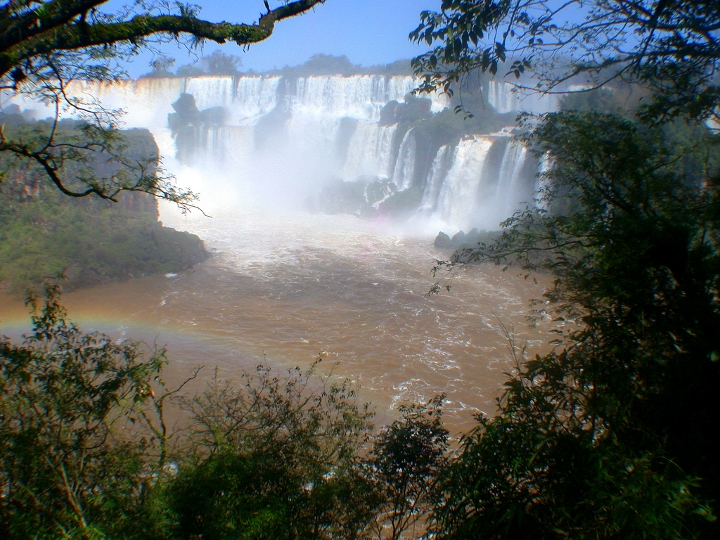
Iguazu Natural Park, one of UNESCO's world heritage sites, is considered one of the most beautiful places on Earth. The Park is situated in both Argentina and Brazil. Photo: Bente Lilja Bye.
Doomsday Scenario 2020
It is 2020. The Svanstroms have lived happily ever after since their trying honeymoon. As they remained on good terms after the turbulent first months of their marriage, surviving the disaster infested journey to Asia in 2010/2011, they enlarged their family and now have two healthy children, a 10 year old girl and a 6 year old boy.
Towards the end of 2020 the Svanstroms, who haven't lost their taste for adventures, want to take their young children on an educational trip to Europe, do some Christmas shopping perhaps while carefully introducing the young ones to different cultures and landscapes. In particular they want to give them the same taste of distant cultures as they have. Following Viking traditions, the Svanstroms therefore plan an extension of their European tour and include a stay in Istanbul (former Constantinople, visited by Vikings some 1000 years ago) in Turkey. Istanbul has managed to keep a peaceful balance of religions, it is still a vibrant mega city with a good mix of old and new cultures and it is inhabited by people from all corners of the world. For the Swanstrom kids, Istanbul seems to be the perfect portal for entering different and distant cultures.
As the Svanstroms make their last preparation for the journey in December, 2020 has already seen an average number of natural disasters. Meaning a little less than in 2010/2011 when they went on the 4 month, 7 disasters trip.
Swiss Re, one of the worlds largest reinsurance companies publish statistics every year in their magazine Sigma. In any given year there are a number of natural disasters and Swiss Re has maintained the statistics since 1970. 2010/2011 turned out to be an above-average active year with respect to natural disasters. The insurance companies keep a track record of natural disasters as basis for their economic estimates and pricing of insurance products.
The same year the Svanstroms returned home after their 7 disasters experience, the US saw one of the worst droughts in ages. The state of Texas was hit particularly hard with numerous bush fires and heat sucking up every drop of water from the surface of the earth leaving many casualties among livestock and wild animals alike.
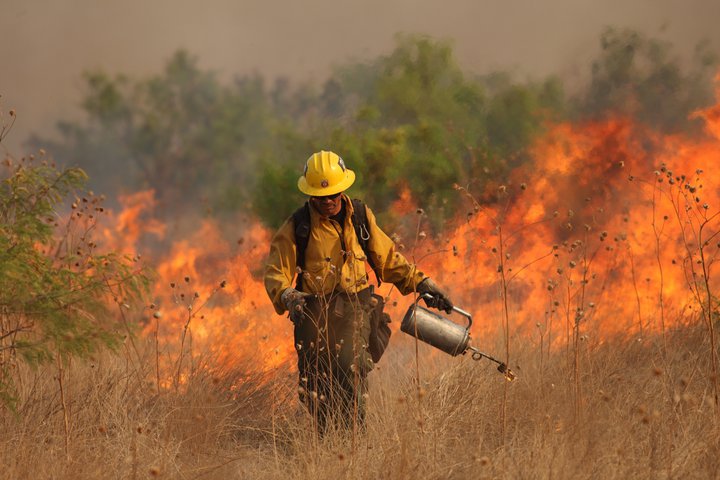
A Texan Forest Service fighter back fires the line to minimize the chances of the blaze jumping the line. Photography courtesy of Texas State Photographer Wyman Meinzer.
In 2011 Texas was the US's second largest economy only beaten by California, and the 12th largest in the world. The economy was also on a rapid rise when the droughts set in. When Texas saw the end of the summer drought in 2011, the Texas State climatologist John Nielsen-Gammon not only concluded that it was a record dry year for Texas but predicted the dry period would last until 2020. He based his prediction on what then seemed to be a new La Nina developing and that usually meant Texas would be deprived of precipitation. Come 2020 and his foresight had sadly been correct. The livelihood of many a Texan rancher had been wiped away by warm and dry La Nina weather. One stock tank after the other had dried up ending with a significant loss of livestock and thus meat production.
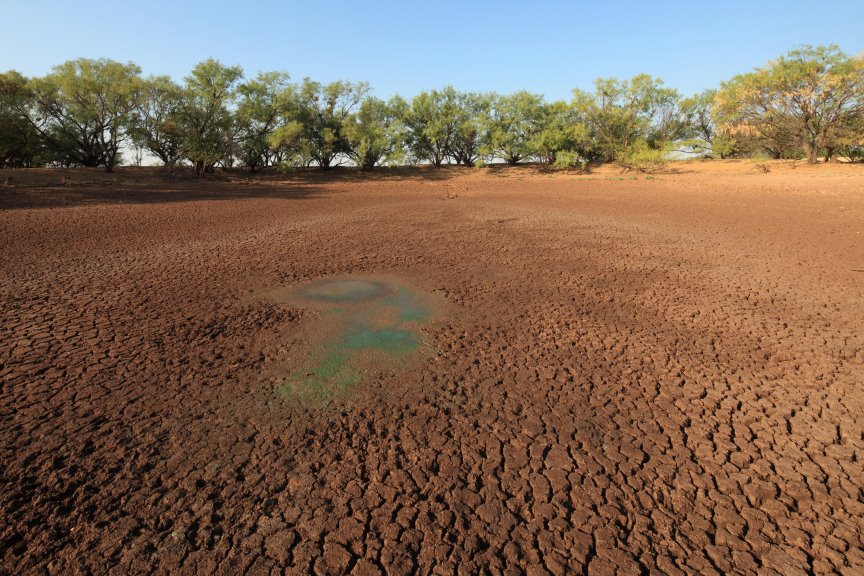
2011 drought in Texas. Water tanks for live stock is drying up.
Photography courtesy of Texas State Photographer Wyman Meinzer.
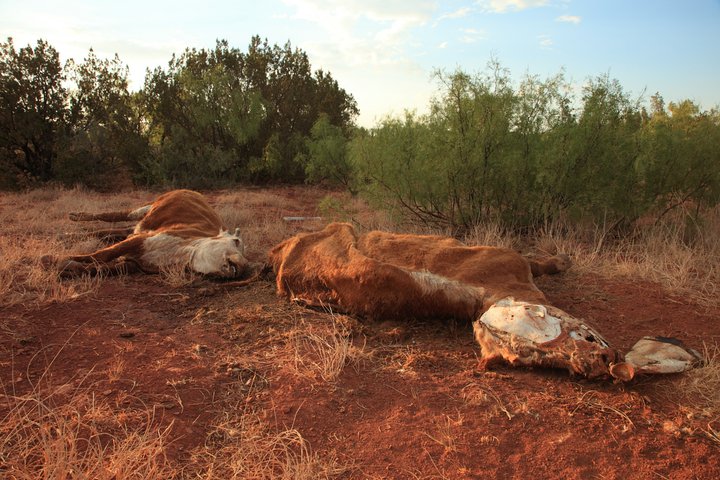
Drought is hitting Texas live stock hard summer and fall 2011. Photography courtesy of Texas State Photographer Wyman Meinzer.
Water rationing hit people, agriculture and businesses alike all in all resulting in the Texas economy to turn from being on a rapid rise to a fast descent. With Texas significant contribution to the US economy, this meant that the US also saw an economic descent, reinforcing a longstanding trend. The world economy had never been more unstable, the entire financial market was extremely nervous.
After a few regular monsoon seasons, Indus had yet again flooded Pakistan just as the country was recovering after the devastating row of floods in 2010-2012. (EO Indus) Late summer and early autumn the hurricane season had as usual rampaged islands in the Caribbean and cities in the US and South-East Asia where particularly Japan was hit hard this year.
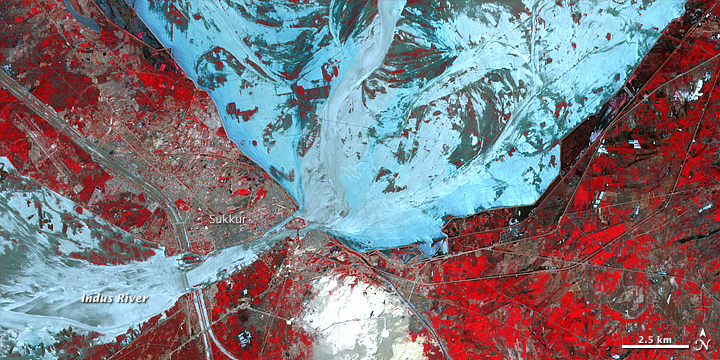
The Indus River at Sukkur, Pakistan was at exceptionally high levels on August 18, 2010. Water ranges from dark blue to silvery blue, and plant-covered land is red in this false-color image.
Credit: NASA.
The world in December 2020 is stressed by natural disasters and nervous financial markets. The UN and regional NGOs work optimistically on fund raising and relentlessly with relief on all continents. Due to the increased interconnectedness and global dependencies, the 2020 economy need longer time to recover from the side-effect/long-term effects from the disasters than we saw in 2011 and raising funds is getting tougher every year. However, the Svanstroms who live in one of the richest and most stable regions on the planet, in Scandinavia, felt that Europe was sufficiently well functioning and they made the decision to make their trip to Europe in December 2020, including Christmas celebration in exotic Istanbul.
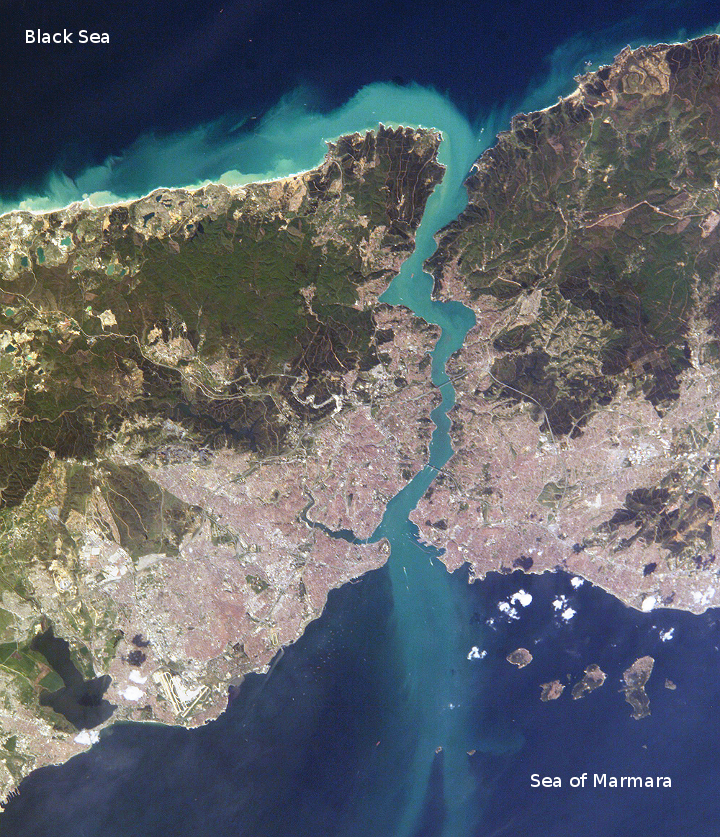
Istanbul is an international metropolis harboring around 20 million people. Photo: NASA
Extreme danger: An Istanbul mega earthquake
Istanbul is literally situated on two continents; Europe and Asia. It is the only city in the world that sits on two continents; the divide defined by the Bosporus strait splitting the city in two halves. Istanbul also sits on another divide; the North Anatolian Fault. From south, the moving Arabian and African tectonic plates are pushing the more stable Eurasian plate, making Turkey highly exposed to earthquakes.
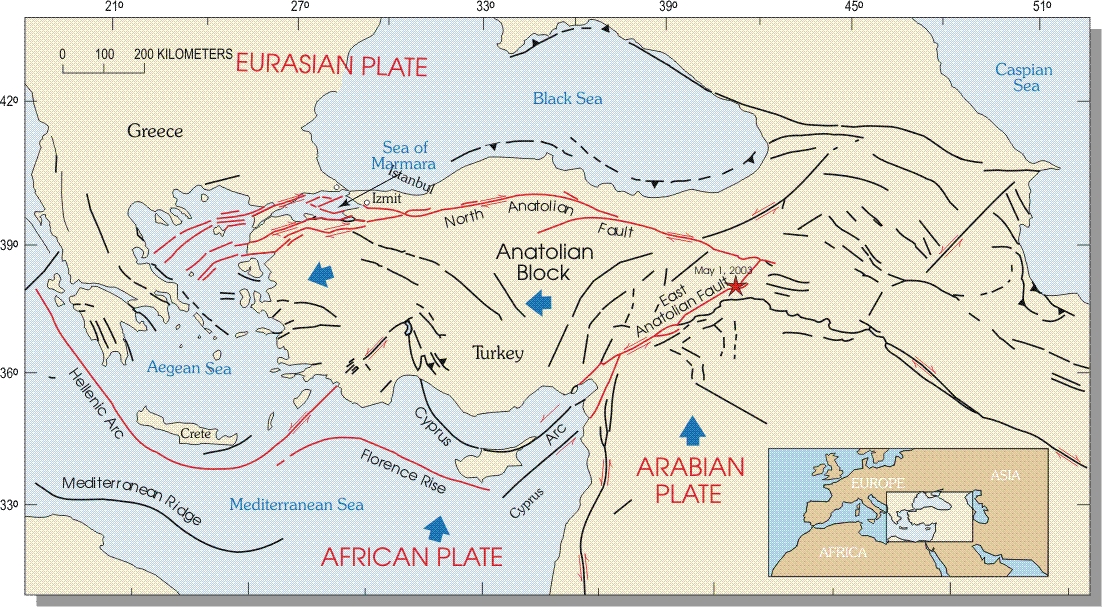 Tectonic map of Turkey, Istanbul. The red lines indicates the faults.
Tectonic map of Turkey, Istanbul. The red lines indicates the faults. In 2020 the city of Istanbul is still a bustling metropolis, as it seemed to always have been, with a great mix of ancient historic buildings and modern facilities. The multi-million city is the most populous in Turkey and continues to be the country's financial center. Unfortunately, city management has only been moderately successful in absorbing decades worth of knowledge about how to build resilient cities. Maybe the task has seemed impossible and taken the courage away from the municipalities, the national government, and the people? How do you prepare an ancient city with more than 20 million people for a mega earthquake? It has been known for years that Istanbul is prone to major earthquakes; scientists have been expecting and warned about The Big One, and many steps could have been taken to mitigate the impact of an earthquake and to make the city more resilient.
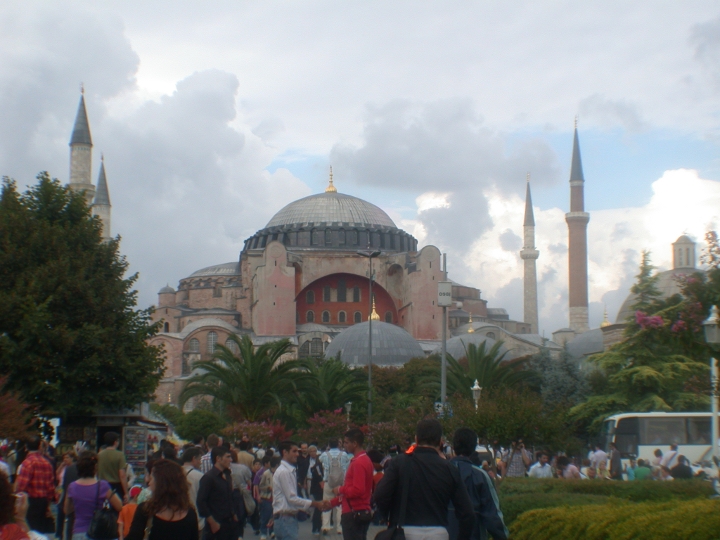 Istanbul is a modern city with lots of ancient history. Here is Hagia Sofia, once a church, then a mosque and today a museum. Photo: Bente Lilja Bye
Istanbul is a modern city with lots of ancient history. Here is Hagia Sofia, once a church, then a mosque and today a museum. Photo: Bente Lilja ByeOn December 23, 2020, the Svanstroms are arriving at Istanbul's Ataturk airport. The children are all excited and the parents are looking forward to a peaceful Christmas holiday in the city. They reserved a hotel in Old City Sultanahmet, and expect some delays on their way from the airport to the hotel due to the dense afternoon traffic just before the long holiday weekend. Suddenly their taxi starts to shake violently and traffic comes to a stand still. This is when I let the shallow M 7.7 earthquake happen with a epicenter only a few km south of Istanbul.
The Svanstroms are lucky because they had not reached their hotel yet. Had they made it to their hotel before the earthquake, they would have died; buried in the grumbles of the hotel. Experienced in living through disasters, they decide to go back to the airport where they gradually learn more about the extent of the devastation in the city.It doesn't take much fantasy to imagine what the M 7.7 earthquake does to Istanbul. The Haitian Port-aux-Price, and Chinese Tangshan quakes amply illustrate the extent of the material damage and loss of lives. But those are only first order effects. In the wake of the event the world economy, which is already shaky, remember, will totally destabilize on a global scale due to second order perils. Not before long the entire world economy will be on a verge of collapse.
On the backdrop of the world experiencing regular extreme weather and regular natural geohazards, the earthquake in Istanbul, in itself an extreme geohazard, certainly qualifies as a doomsday embryo.
More extreme danger: multiple extreme geohazards
To make it more interesting, let me throw in a few more incidents in this scenario.
Moving south-east to the Philippines, we find a number of famous volcanoes. Several of these volcanoes are explosive, and one of them had shown signs of unrest starting in 2019. On December 23, 2020, just a few hours after the earthquake hit Istanbul, a major eruption takes place flinging huge masses of volcanic ash into the atmosphere. In 1883, the island of Krakatoa exploded, killing at least 40,000 people, and ejecting more than 20 cubic-kilometers of rocks, ashes, and dust into the atmosphere. In 2020, the hypothetic island explosion is of similar size, easily 10 times as big as the 2010 Eyafjallajökull eruption that grounded air traffic in Europe for a week. A few hours after the eruption, all flights in and out of Asia are canceled and the much needed support for Istanbul from the by now richest region in the world, with medicine and other life saving aid, is blocked.
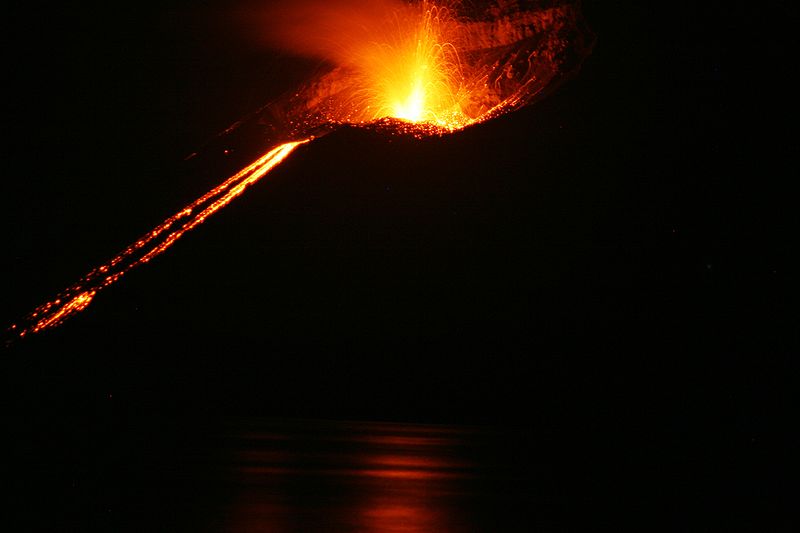 From the Krakatao eruption 2008. Source Wikipedia
From the Krakatao eruption 2008. Source WikipediaIt starts to resemble a doomsday now, doesn't it? Let me now add a final event. Our planet is of course not isolated from the rest of the universe and natural disasters can be caused from space, too. On September 1-2, 1859, the most powerful solar storm in recorded history caused considerable damage to telegraph systems in wide regions of the planet. As illustrated by smaller, more recent solar storms, today the impacts of these solar events are multiplied, due to our dependency on electrical equipments and power grids.
When a rather large M 3.6 class flare occurred near the edge of the Sun on Feb. 24, 2011, it blew out a gorgeous, waving mass of erupting plasma that swirled and twisted for 90 minutes. NASA's Solar Dynamics Observatory (SDO) captured the event in extreme ultraviolet light. When these kind of eruptions are big enough and directed towards the Earth, the resulting solar storm can cause major damage. Credit: NASA SDO
On December 21, 2020, a solar flare so violent it creates the largest solar tsunami ever observed with modern instruments had been registered rushing directly towards our planet. Space agencies like ESA (Europe) and NASA (US) in West and JAXA (Japan), ISRO (India) and CNSA (China) in East had issued warnings of a solar storm and the world was preparing for the impact when the earthquake and the volcano eruption took place. Only hours after the volcanic eruption in East Asia, the solar storm arrived. It knocked out all the Global Navigation Satellite System (GNSS); GPS, GLONASS, the brand new Galileo and COMPASS, all of them. Dead. No signals. It also knocked out many power grids and other electric infrastructure, particularly in North America and Europe. These knock-outs eliminated North America and most of Europe, in particular Scandinavia, as supporters for the disaster response in Istanbul.
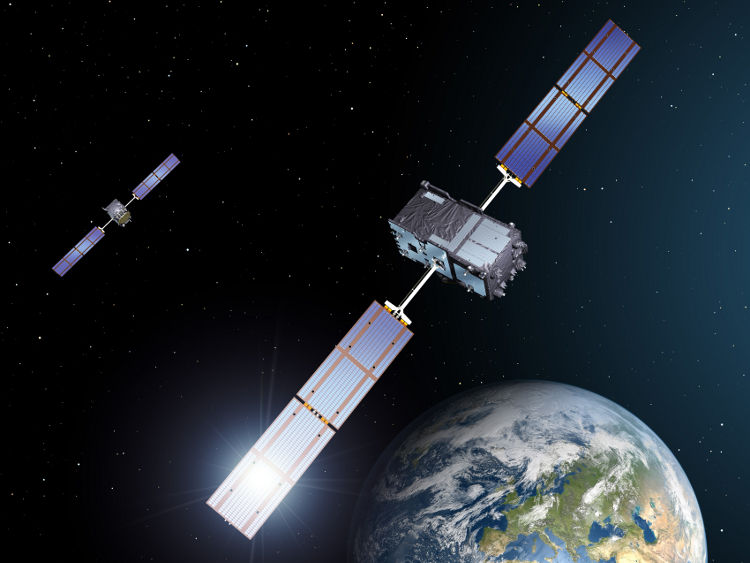 Galileo satellites. Satellites are susceptible to solar storms and can be 'knocked out' for a while. Credits: ESA - P. Carril
Galileo satellites. Satellites are susceptible to solar storms and can be 'knocked out' for a while. Credits: ESA - P. CarrilThe Svanstroms have reached back to the airport in Istanbul. They realize that they will be stuck there for some time, with little functioning infrastructure, practically no food reserves and no city to escape to. Optimistically trying to find a way out, they learn about the volcano eruption and the mounting impacts of the solar storm. Their optimism evaporates when they finally hear, almost as if to reproduce the experience of the 2010/2011 disaster sequence, that a severe winter storm is forecast for the next days for Greece and Turkey. Road and marine transportation will at best be difficult, if not impossible. Tough luck for the Swanstroms – again. In 2010/2011, they experienced seven disasters over four months in a sequence in different locations on the planet. This time, in 2020, they only stay in one location for a few days and yet experience the impacts of a sequence of four disasters!
The whole world stops. And that is the end of the story. Or is it not?
Black Swan Events
What fascinates us about the Swedish newlyweds story is that their journey was packed with such an unlikely high number of natural disasters. What are the chances that when you go on a honeymoon you end up experiencing only ONE disaster? Rather slim, right? They were touched by 7 geohazards during a period of 3-4 months. It is possible to do some mathematics and statistics on the probability/odds of that of course.
To a large extent we know where we can expect geohazards to occur as they mostly are found to happen in and around tectonic plate boundaries. Early warning systems have been developed for tsunamis and volcanoes (see article on ash warning here) whereas earthquakes shows fewer signs before they happen and early warning systems are only being used after the fact in order to shut down crucial infrastructure to reduce damages.
No matter where we live, we are all familiar with and know how to act with respect to weather forecasts (early warning system for weather), which also are partly based on observations, partly on models.
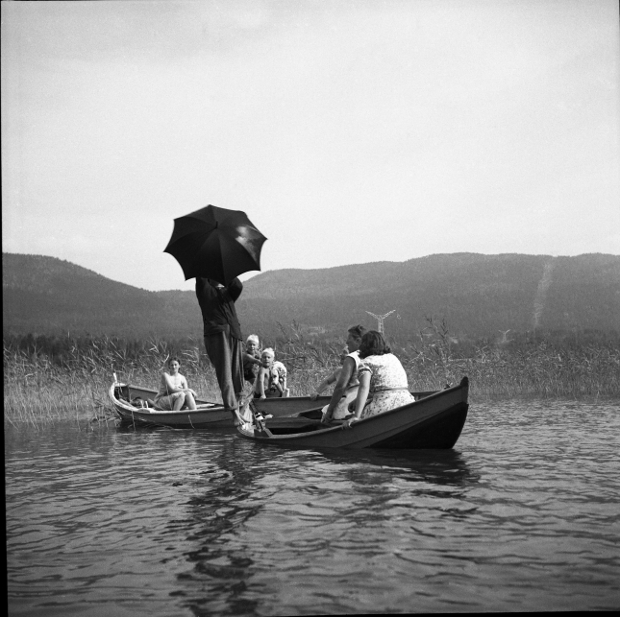
If the weather forecast says it will rain, you bring, for instance, and umbrella with you. Photo: Per Birger Bye
Probabilistic approaches have been developed for weather forecasts and earthquakes. In many ways it is similar to gambling. When talking about probabilities odds can be calculated. What are the odds for a mega earthquake in Istanbul? Based on current scientific knowledge where use of probabilistic models are integrated in the scientific methods, most scientists agree that an earthquake will hit Istanbul. The uncertainty lies first and foremost in when it will happen, not if. And managing uncertainty is a key issue in disaster management.
Nassim Nicholas Taleb, the stock trader turned academician, described the theory of Black Swan Events in his book The Black Swan: The Impact of the Highly Improbable (2007). A Black Swan Event has to be both a real surprise (highly improbable, great uncertainty with respect to if and when estimates of an event), have a major impact and be explainable in hindsight. An earthquake in Istanbul will arguably have a huge impact, but it will not come as a surprise as we know the odds are high we'll see an earthquake there sooner rather than later.
On one extremely beautiful afternoon on lake Steinsfjorden, Åsa, Norway, a white swan graciously swims by. It wasn't until 1697 that we in the West discovered black swans in Australia. Up until then it was considered impossible that swans came in black and therefore a 'black swan' was incorporated in the English language as an expression of the impossible or unlikely.
In this 2020 scenario, note that each and everyone of the four events; Istanbul earthquake, Philippine volcanic eruption, solar storm and extreme winter storm, are realistic. We know these or similar events will happen. The probability that all four events happen at the same time is however, very, very small. Since the impact will be immeasurably huge and we can explain it, it can be described as a Black Swan Event.
Trying, failing and learning from it (heuristic) do not seem like a good approach when it comes to managing natural disasters, events that are difficult or even impossible to predict. Intuitively, we think that both the human and material costs are way too high for that. However, according to Nassim Taleb a decision strategy that includes designing systems that are founded on the simple heuristic, fragility and antifragility ideas lending support to disaster management that would actually gain from Black Swan Events. (A fragile object will be destroyed by a wide range of shocks. A robust object will survive a wide range of shocks. An “anti-fragile” object would actually become stronger when exposed to a wide range of shocks. If we run the same scenario but with a global society that has applied the knowledge about resilience and included Talebs ideas of antifragility, the destructive consequences of a multi-mega disaster may very well be reduced and a resulting doomsday-like situation avoided.
The Fantastic Four - What are extreme geohazards?
As devastating as extreme weather can be, it is the Fantastic Four that have the power to cause planetary doomsday-like scenarios. I am of course not referring to the comic book figures, nor do I involve Doctor Doom. I'm talking about the extreme, strategically placed, versions of earthquakes, tsunamis, volcano eruptions and landslides. These furious forces of nature can cause havoc beyond our wildest dreams – or nightmares rather. Not when they happen in remote Kamchatka or unreachable Himalayas, but when they hit the urbanized areas like Istanbul, San Francisco, Jakarta and many more places.
Vulnerability
Due to increased urbanization we are increasingly exposed to potential multi-mega disasters. Today more than 50 % of world population lives in cities. Not only do we live in cities, we migrate towards the coasts, exposing lives and assets to a combination of, for example, mega earthquakes, monstrous tsunamis, large cyclones, and sea level rise. The UN (2008) expect that 70% of us will live in cities by 2050. Our interconnected global society is increasing its vulnerability with respect to the forces of nature, rather than reducing it.
I do not believe in any kind of doomsday, they are inventions of fantasy one way or another. The extreme geohazards however are very much real and may be experienced like a doomsday if you are in the midst of one, let alone live through a combination of several extremes like in the scenario described above.
Understanding Extreme Geohazards: The Science of the Disaster Risk Management Cycle
The European Science Foundation-COST high-level conference “Understanding Extreme Geohazards: The Science of the Disaster Risk Management Cycle” in November/December 2011, will gather leading experts on the various aspects of extreme geohazards. Scientists work steadily on improving their understanding of these forces of nature, where we can expect to see them manifest themselves, in what fashion and their timing. The big question is do we really know what to expect? And are we really prepared to manage the extreme geohazards? These and other related questions will be addressed during the week long conference in Spain.
In the doomsday scenario for December 2020, economic aspects and mitigation are briefly mentioned, and I will specifically come back to what roles humans play in turning geohazards into disasters – or in preventing them from developing into doomsday-like disasters. Stay tuned to get reports from “Understanding Extreme Geohazards: The Science of the Disaster Risk Management Cycle” conference 27. November – 2. December 2011.
Since The Svanstrom's are real people we'll let them survive their second encounter with disasters, but that is really against all odds.
About the author.
Bente Lilja Bye, CEO at BLB, has experience from developing early warning systems for geohazards and is a member of the program committee of the ESF-COST Extreme Geohazards conference.
Acknowledgement: Prof. Hans-Peter Plag, UNR, USA
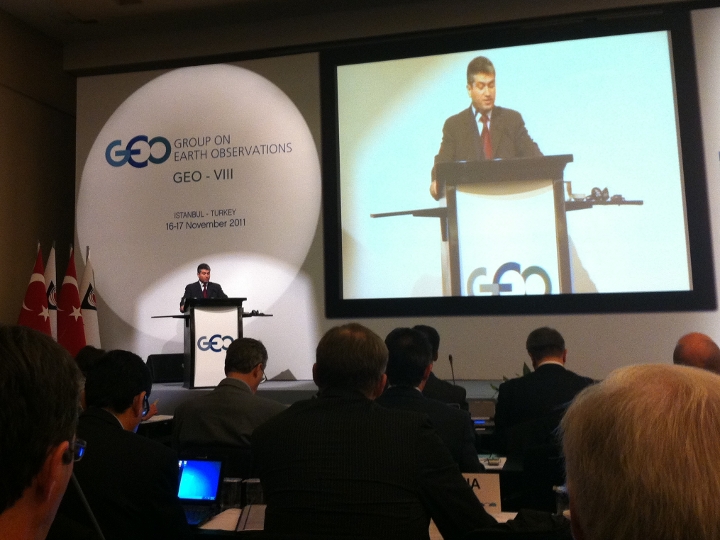 The Turkish host welcome the GEO plenary. Photo: Bente Lilja Bye
The Turkish host welcome the GEO plenary. Photo: Bente Lilja ByeThe author is taking her chances and attends the GEO plenary meetings November 2011 in Istanbul. While Istanbul, an extremely beautiful city, must be considered to be in a high geohazard risk area (extreme danger), next years plenary will be in Brazil at Iguazu, a spot known for its extreme beauty with no extreme geohazard risk attached to it.


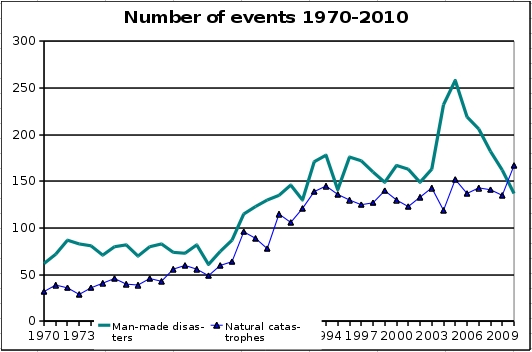


Comments